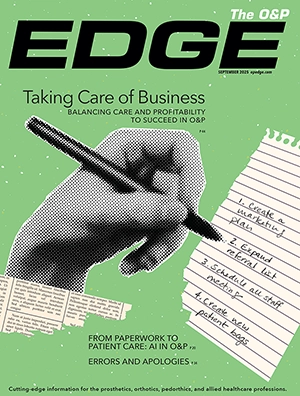While upper-limb osseointegration (OI) offers an expanding menu of benefits as research progresses, some with upper-limb loss may not consider it a desirable option.
Brooke O’Steen, OTR, upper extremity clinical and educational specialist, ForMotion Clinic (formerly SRT Prosthetics and Orthotics), Indiana, observes that people with trauma-based limb loss may be reluctant to undergo a second surgery.
“These patients have gone through one of the most horrible things that could ever happen to them—whether at the wrong place, wrong time, or due to a bad decision—something horrible. This kind of trauma is the leading cause of upper-limb loss, unlike lower-limb loss, which is more often due to vascular disease.”
The gradual deterioration of lower limbs due to vascular disease or diabetes, which O’Steen describes as “a slow, progressive burn,” allows time for those affected to get used to the possibility of eventual amputation.
“At some point along the line they’re hearing how their wound isn’t going to heal—or they just get tired of it, and it almost becomes more of an elective amputation—not always, but they know it’s coming. It’s preemptive; they can see the result as the light at the end of the tunnel.
“With upper-limb,” she explains, “it’s an instant event; they get in a helicopter or a really fast ambulance, and they end up in a trauma bay where they don’t get any decisions at all. So we just don’t see as many revisions or post-surgical interventions because they’re struggling to cope with the original amputation.
“We saw the same thing with TMR [targeted muscle reinnervation] or RPNI [regenerative peripheral nerve interface] surgeries. I think unless we make a large change—to do these implants for electrodes at the time of the initial amputation—you’re going to see a patient population that is quite hesitant initially to go back to surgery and open things up and do something with it,” she warns.
“They spend so much time trying to get healed—whether that’s with skin grafts or a free flap, or something like that—that going back in and asking them to do something like implantable electrodes might be a far reach initially, until we can show them very convincingly the magnitude of how much easier it is for somebody to operate a device.”
Who’s a Candidate?
Even patients who are ready and willing to embrace the idea of surgery and a state-of-the-art upper limb that can respond promptly and deftly to their wishes may not be ideal candidates for the program. But some patients unsuited for traditional prostheses may find OI a surprising solution.
Haris Kafedzic, CPO, director of prosthetics, Eschen Prosthetic & Orthotic Labs, New York, describes two transulnar patients who were not candidates for traditional prostheses.
“Because their bones inside [their residual] limbs were so short, they would typically have been treated as transhumeral, or above-elbow, amputees. That would have required adding an artificial elbow and suspending the prosthesis above the shoulder. However, both patients had functional elbow joints they could control naturally. Thanks to osseointegration, they were able to use a prosthesis as below-elbow amputees rather than being forced into above-elbow prosthetic solutions.
“That said, osseointegration is something patients must be truly prepared for. To be good candidates, they need to understand the risks involved and accept that the healing process takes longer. The four osseointegration patients I’ve worked with were all well informed, prepared, and committed to success. None have regretted their decision, and all remain very satisfied with their prosthesis.”
Recommendations
Despite the complexity and potential risks of the upper-limb OI process, O’Steen advises potential candidates not to overthink it.
“We have worked with three bilateral upper-limb patients who have had osseointegration and it’s been absolutely life-changing for them. We are currently in our first round of what we would call unilateral patients: able-bodied on one side and amputation on the other. Both of them are transhumerals who have a sound side.
“I think anybody at a transhumeral level should consider [OI] and talk with someone who can explain about the gravitational pull of the socket, the suspension, overhead motion and function, and just ease of use of a prosthesis…and what it could mean for them.
“Is it right for everybody? No. But everybody deserves that education because it eliminates the socket and the hassle of the socket. It’s not that much different than a conventional prosthesis—it just changes the method of suspension, and that’s okay; we can make it as simple or as complicated as it needs to be. We’re just looking for the right way to give the patient the best opportunity to be independent and that’s with, potentially, OI, an appropriate technology. It doesn’t have to be crazy; it just has to be appropriate for the patient. At the end of the day, OI is just another tool in the toolbox as a fitting method.
“Our office has fit three transhumerals and a thumb, and we’re [planning to fit twice that by year end]; all you need to be successful is a motivated patient with the desire to live and learn—and they’re going to be just fine,” O’Steen says.
Read more at “Upper-Limb Osseointegration: Connections on a Higher Plane.”
.Judith Philipps Otto is a freelance writer who has assisted with marketing and public relations for various clients in the O&P profession. She has been a newspaper writer and editor and has won national and international awards as a broadcast writer-producer.
Circles art: MooJook/stock.adobe.com



